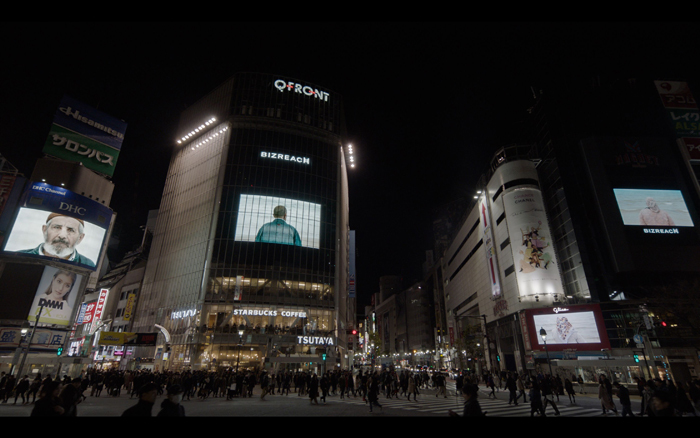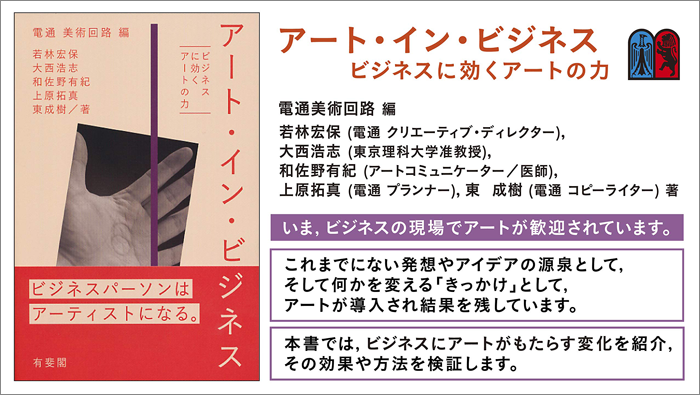I am Takuma Uehara, a member of Bijutsu Kōro (※) and one of the authors of 'Art in Business: The Power of Art That Works for Business'. In the first installment of this series, titled "How Does Art Work for Business?", I introduced why art is gaining attention in business settings and the relationship between Art Power and Art Effects.
In Part 2, we'll discuss "internalizing art"—a concept frequently mentioned in the book—as a way for individuals to acquire art power, using examples from BizReach (now part of the Visional Group).
(※) Bijutsu Kōro: An art unit supporting business creation that incorporates art power. Dedicated site: https://www.bijutsukairo.com/
Why Business "Persons" Should Embrace Art "Power"
Internalizing art means embedding art power (the four core strengths of artists: problem-posing ability, imagination, practical skills, and co-creation ability) within oneself. Simply put, it refers to the state where, through experiences engaging with art, art power becomes part of one's very being, enabling independent thinking and action.

The Four Art Powers and Internalization
Why is internalizing art important for business professionals? While the book presents the hypothesis that "incorporating art into business is effective," what we truly want to assert is that "incorporating art power into business people is meaningful."
Activities like featuring artworks on product packaging or displaying contemporary art in offices are certainly wonderful in their own right. However, before that, it is crucial for business professionals to deeply reflect on how this relates to their own work by emulating artists who create autonomously.
Internalization isn't necessarily limited to art alone
While the book primarily examines artists' thinking and sensibilities, it's not necessarily true that only artists possess art power. This article will focus not just on art in the narrow sense (artists and their works), but also on art in the broader sense (all creative acts) or the value of art power itself.
What kind of person possesses all five art powers: problem-posing power, imagination, practical power, and co-creation power? Some might feel opportunities to encounter art or artists are rare. Yet, individuals embodying these four art powers are, in the business world, top-tier super businesspeople. In fact, the founders of startups—well-known to business professionals—fit this description.
Startups are like artists
Why do founders or executives who build startups possess these art powers? Let's examine each one.
First, regarding problem-posing ability: they deeply explore what they want to do, connect their aspirations with societal needs, and pose the question, "This is how the world should be." They creatively imagine concepts that don't yet exist in the world and struggle to bring them to life.
They also possess the practical ability to persistently and proactively pursue their mission despite various constraints (fundraising, talent development, legal reforms, etc.). They demonstrate co-creation capabilities, engaging not only internally (management, employees) but also externally with diverse stakeholders (shareholders, partners, users, competitors, platforms) and society at large.
Do you have opportunities to interact with startup founders or executives? I've been fortunate to collaborate with artists and startup founders both professionally and personally. Discussing with startup founders, I often think, "These people are just like artists," or conversely, when interacting with artists, I'm often surprised, wondering, "Why is this person so business-savvy?"
Both artists and startup founders sense societal issues, deepen their imagination, put ideas into practice despite various hardships, and ultimately co-create with all kinds of people. Immersed in their overflowing energy, I found myself resonating with their passion and, before I knew it, had absorbed this art power into myself.
Why BizReach Sponsored Contemporary Art
For example, BizReach (now part of the Visional Group), which operates various internet services like a recruitment platform, can be seen as a startup that embodies the internalization of art. In February 2019, the company resonated with the work of French contemporary artist Sophie Calle and sponsored an artwork: screening her video piece "Voir la mer (Seeing the Sea)" on the street-level vision screens at Shibuya Scramble Crossing.
Visional Group explained its sponsorship rationale as follows:
To continuously create new businesses, we need the ability to perceive the world and industries from fresh perspectives and find meaning within them.
The core principles of a startup's new ventures and an artist's creative process seem fundamentally aligned.

Video work screened at Shibuya Scramble Crossing: Sophie Calle "Voir la mer (Seeing the Sea)"
The decision to sponsor came from Mr. Makoto Takeuchi, Director and CTO of Visionary (at the time of sponsorship: Director and CTO of BizReach). Mr. Takeuchi is not an artist, nor did he receive formal art education. He loved math from childhood and even aspired to be a mathematician. He studied mechanical engineering in university and started his career as an engineer at a major IT company. However, Mr. Takeuchi internalized his own sense of art power and chose to sponsor Sophie Calle as an act of giving form to that conviction. Here's what he shared when I met him:
I don't know if it counts as art, but as a child I loved stamps and collected them. I also loved music, so in my twenties I dabbled in singer-songwriter activities. My first art experience was buying a painting from a friend I met through music for about 5,000 yen.
While Mr. Takeuchi now has a strong interest in contemporary art, this connection is quite recent; art wasn't originally a part of his everyday life. However, his way of perceiving and thinking about things is truly artistic.
There are two types of engineers. One type builds exactly what they're told to build, following specifications. The other type has something they want to create, so they design it themselves and build it from scratch – an imaginative engineer. If you put a brush in the hands of the latter type of engineer, wouldn't they become a painter, an artist?
The business professionals who have internalized the "art power" we describe in our book are precisely those defined by Mr. Takeuchi: people who delve deep into their own hearts, clarify what they truly want to do, and put it into practice in the business world.
What was particularly interesting in Mr. Takeuchi's story was the restaurant his parents ran on the first floor of their family home.
From childhood, he observed customers coming and going, developing a business instinct—like estimating daily sales.
It seems he naturally received this kind of business education (?) from a very young age. Then, through mathematics and stamp collecting, Takeuchi became a young man passionate about programming and music.
Perhaps precisely because Mr. Takeuchi has experienced both art and business in a broad sense since childhood, he is able to put art power into practice within business. Rather than connecting art and business, he uncovers the hidden art power within everyday business and gives it form. I believe the essence of Art in Business lies in this very approach.
Businesspeople Become Artists
As a businessperson who struggles myself, I wrote this book to share a message with others who feel similarly. I can already hear the responses: "But you can't just do what you love at work," or "I've forgotten if I even had something I wanted to do in the first place."
If you feel that way, I hope you'll take me as a reference. While I studied art briefly in university, I became completely disconnected from so-called art after starting my career. Now, I work in data analysis, and many of my colleagues have never been to an art museum. Mr. Takeuchi has a similar background, and I deeply resonated with him.
Art isn't just the pieces displayed in museums, musicians' performances, or films and plays. I believe art is hidden within ordinary work and everyday life. I wrote this book hoping you'll connect your true feelings – those thoughts like "This would be so much more enjoyable if..." or "I secretly think this, but it's hard to say" – to your work in a meaningful way.
I chose the slogan "Businesspeople Become Artists" for the book's cover. This slogan embodies my hope that each of you will concretely put your business into practice—for the company, for society, and for yourselves. If you're a troubled businessperson like me, I recommend starting by sharing your concerns with artistic businesspeople like Takeuchi-san, in the broadest sense. Please internalize your art power and practice business in your own unique way.






